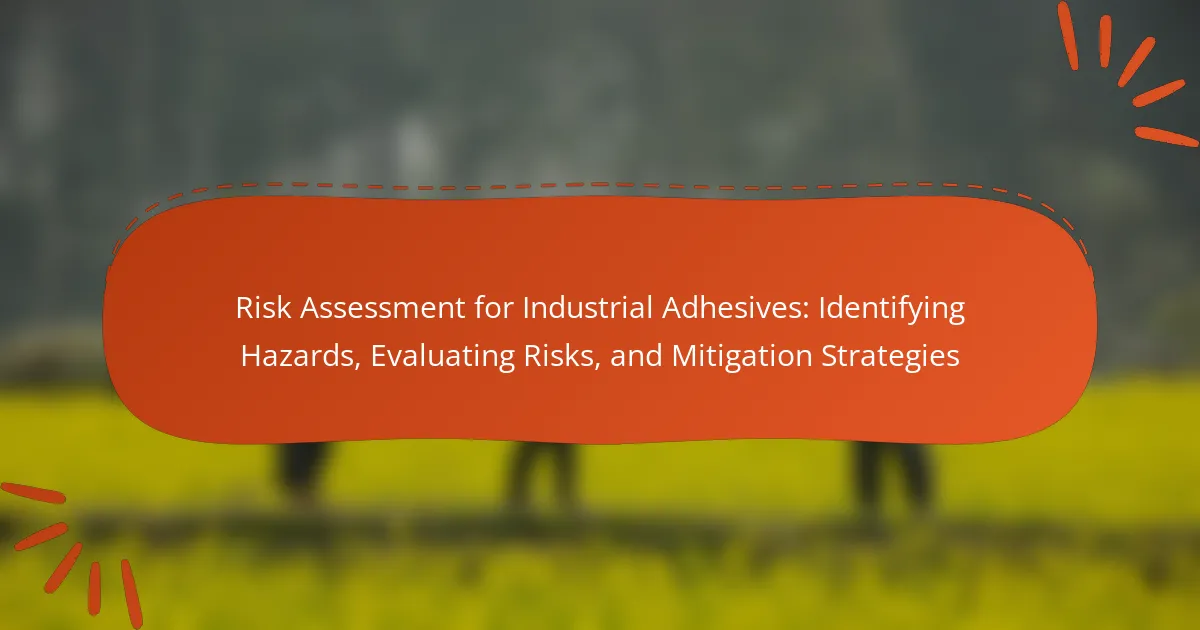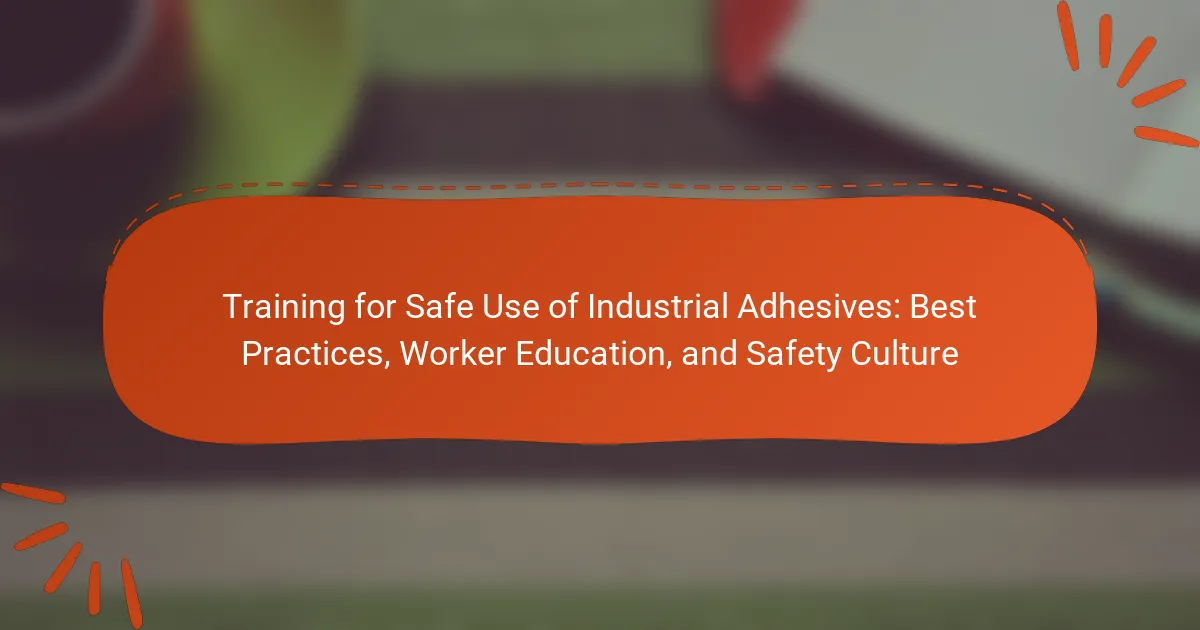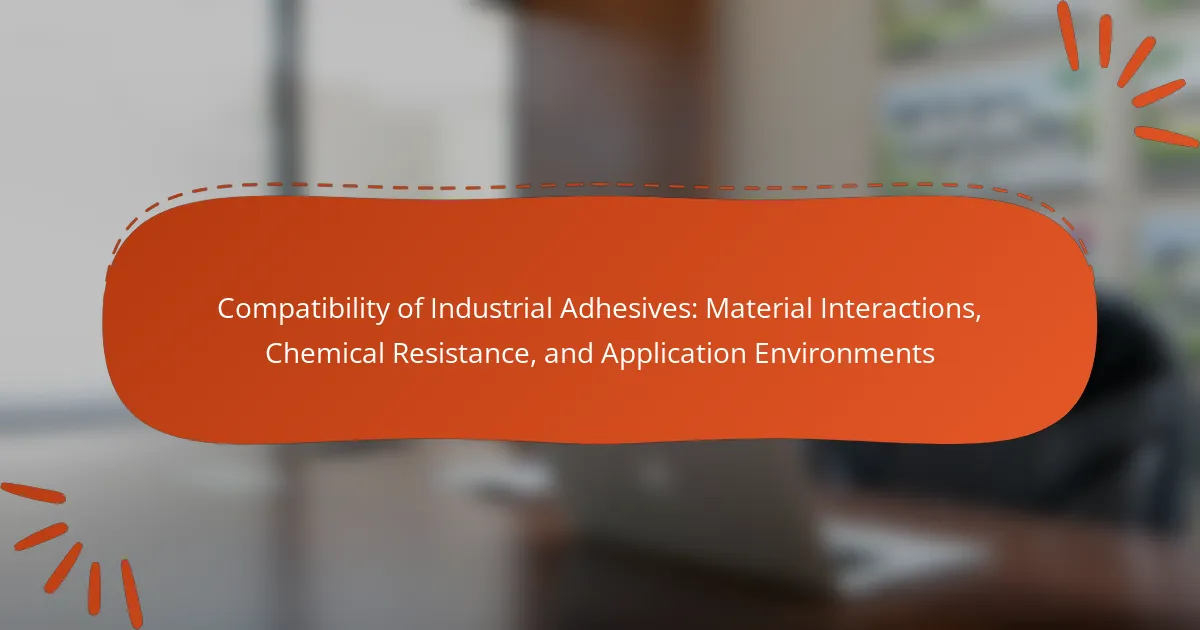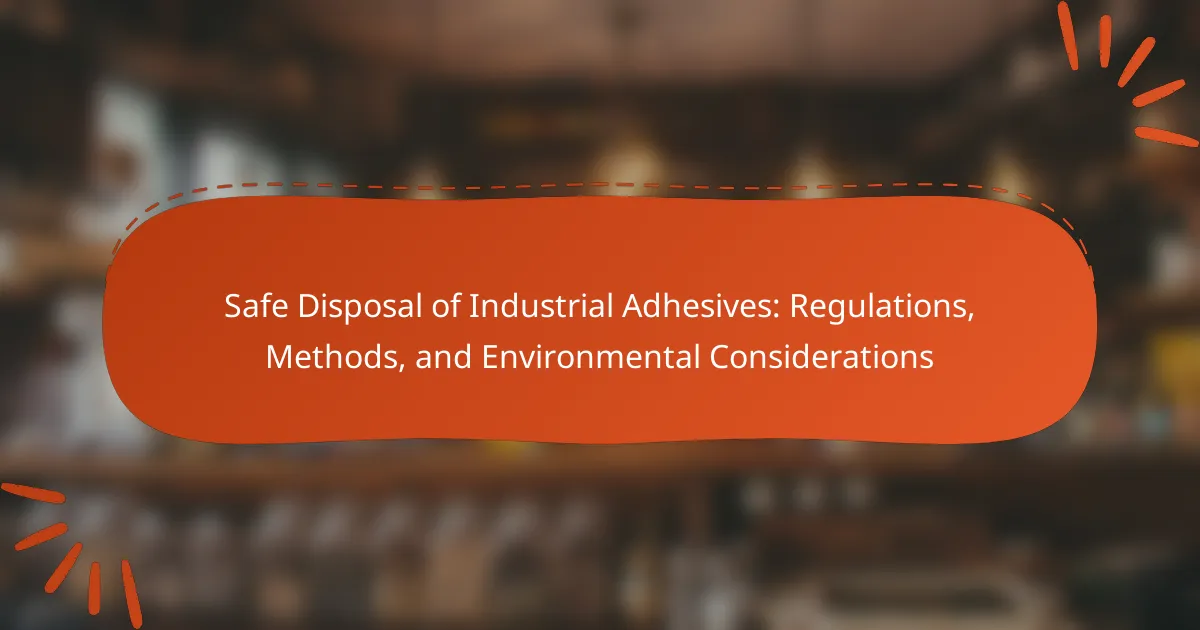Risk assessment for industrial adhesives is a critical process that identifies potential hazards linked to their use, focusing on health and safety during production and application. This assessment evaluates risks such as chemical exposure, fire hazards, and environmental impacts, which vary based on the adhesive’s composition and application methods. The article outlines systematic approaches for hazard identification, including the review of Material Safety Data Sheets (MSDS), employee interviews, and the use of hazard identification tools. It also discusses the evaluation of risks associated with these adhesives, leading to the development of effective mitigation strategies that encompass engineering controls, personal protective equipment (PPE), and employee training. Through regular monitoring and adherence to regulatory guidelines, the structured risk assessment process aims to enhance workplace safety and compliance with safety standards.
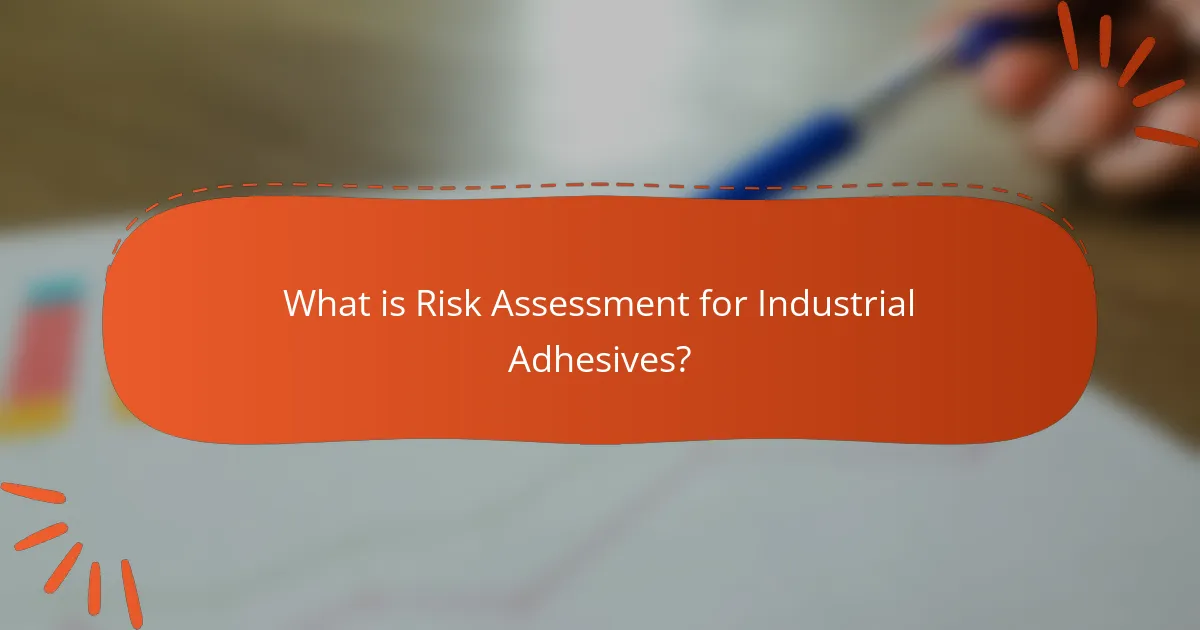
What is Risk Assessment for Industrial Adhesives?
Risk assessment for industrial adhesives involves identifying potential hazards associated with their use. This process evaluates the risks to health and safety during production and application. It includes assessing chemical exposure, fire hazards, and environmental impacts. Each adhesive may present unique risks based on its composition and application methods. Regulatory guidelines often dictate the assessment process. Proper risk assessment can lead to safer handling practices and improved workplace safety. Evidence shows that systematic risk assessments reduce incidents and enhance compliance with safety standards.
Why is Risk Assessment important in the context of Industrial Adhesives?
Risk assessment is crucial in the context of industrial adhesives to identify potential hazards. It helps in evaluating the risks associated with adhesive materials and their application processes. By assessing risks, companies can implement safety measures to prevent accidents. For instance, certain adhesives may release harmful fumes during application. Identifying these risks allows for proper ventilation and protective equipment to be used. Moreover, risk assessment ensures compliance with industry regulations and standards. This minimizes legal liabilities and promotes a safer workplace. Overall, thorough risk assessment enhances product safety and operational efficiency in adhesive applications.
What are the potential consequences of inadequate risk assessment?
Inadequate risk assessment can lead to severe consequences in industrial settings. These consequences include increased likelihood of accidents and injuries among workers. For instance, a study by the National Institute for Occupational Safety and Health found that poor risk evaluation contributed to 40% of workplace incidents. Additionally, inadequate assessments may result in financial losses due to equipment damage or production downtime. Companies could face legal liabilities if they fail to comply with safety regulations. Furthermore, inadequate risk assessment can damage a company’s reputation, leading to loss of customer trust. Ultimately, neglecting thorough risk evaluation undermines overall safety and operational efficiency.
How does risk assessment improve safety and compliance?
Risk assessment improves safety and compliance by systematically identifying and evaluating potential hazards. This process allows organizations to implement appropriate control measures. Effective risk assessment leads to reduced incidents and injuries in the workplace. It ensures adherence to regulatory standards and legal requirements. For instance, companies that conduct regular risk assessments report a 50% reduction in workplace accidents. This proactive approach fosters a culture of safety among employees. By prioritizing risk management, organizations demonstrate their commitment to employee well-being. Overall, risk assessment is essential for maintaining a safe and compliant work environment.
What are the key components of Risk Assessment for Industrial Adhesives?
The key components of Risk Assessment for Industrial Adhesives include hazard identification, risk evaluation, and risk control measures. Hazard identification involves recognizing potential hazards associated with adhesive materials. This can include chemical exposure, flammability, and environmental impact. Risk evaluation assesses the likelihood and severity of adverse effects from identified hazards. This process often uses qualitative and quantitative methods to determine risk levels. Risk control measures are strategies implemented to mitigate identified risks. These may include engineering controls, personal protective equipment, and safe handling practices. Effective risk assessment ensures compliance with safety regulations and promotes a safe working environment.
What types of hazards are associated with industrial adhesives?
Industrial adhesives can pose several types of hazards. These include chemical exposure, fire risks, and health impacts. Chemical exposure can occur through inhalation, skin contact, or ingestion of toxic substances in adhesives. Many industrial adhesives contain volatile organic compounds (VOCs) that can cause respiratory issues. Fire risks arise from flammable solvents present in some adhesives. Health impacts can range from skin irritation to more severe conditions like chemical burns or allergic reactions. Proper safety measures and personal protective equipment are essential to mitigate these hazards.
How is risk evaluated in the context of industrial adhesive usage?
Risk in the context of industrial adhesive usage is evaluated through systematic hazard identification and risk analysis. The process begins with identifying potential hazards associated with adhesive materials, including toxicity, flammability, and environmental impact. Next, the likelihood of exposure to these hazards is assessed. This involves evaluating the conditions under which adhesives are used, such as ventilation and personal protective equipment.
Risk analysis also includes assessing the severity of potential health effects, which can range from minor irritation to serious health issues. Quantitative data, such as exposure limits and toxicity levels, are often utilized in this evaluation. Regulatory guidelines, such as those from OSHA or EPA, provide frameworks for assessing risks related to chemical exposure.
Additionally, safety data sheets (SDS) for specific adhesives offer critical information on hazards and recommended safety measures. By combining hazard identification, exposure assessment, and severity analysis, a comprehensive risk evaluation can be performed. This ensures that appropriate mitigation strategies are implemented to minimize risks associated with industrial adhesive usage.
What methodologies are used in Risk Assessment for Industrial Adhesives?
Risk assessment for industrial adhesives employs various methodologies. Common methodologies include qualitative assessments, quantitative assessments, and hazard analysis techniques. Qualitative assessments involve expert judgment to identify potential risks and their impacts. Quantitative assessments use statistical data to evaluate risk likelihood and consequences. Hazard analysis techniques, such as Failure Mode and Effects Analysis (FMEA) and Hazard and Operability Study (HAZOP), systematically identify and analyze potential failure points. These methodologies help ensure safety and compliance in adhesive applications.
What is the role of qualitative vs. quantitative assessments?
Qualitative assessments focus on descriptive data and subjective analysis. They help identify potential risks through expert opinions and observations. This approach is useful for understanding complex scenarios where numerical data may be lacking. Quantitative assessments, on the other hand, rely on numerical data and statistical analysis. They provide measurable and objective evaluations of risks. This method allows for precise calculations of probabilities and impacts. Both assessments complement each other in risk evaluation. Qualitative assessments can highlight areas needing further quantitative analysis. Quantitative assessments can validate qualitative findings with hard data. Together, they enhance the overall understanding of risks in industrial adhesive applications.
How do industry standards influence risk assessment practices?
Industry standards significantly influence risk assessment practices by providing a framework for evaluating hazards. These standards establish criteria for identifying potential risks associated with industrial adhesives. They guide organizations in implementing consistent methodologies for risk evaluation. Compliance with industry standards ensures that assessments are thorough and systematic. For example, the ISO 31000 standard outlines principles for effective risk management. This standard helps organizations identify, assess, and prioritize risks effectively. Moreover, adherence to standards enhances communication and understanding among stakeholders. It also promotes best practices, leading to safer work environments. Ultimately, industry standards help organizations mitigate risks associated with industrial adhesives.
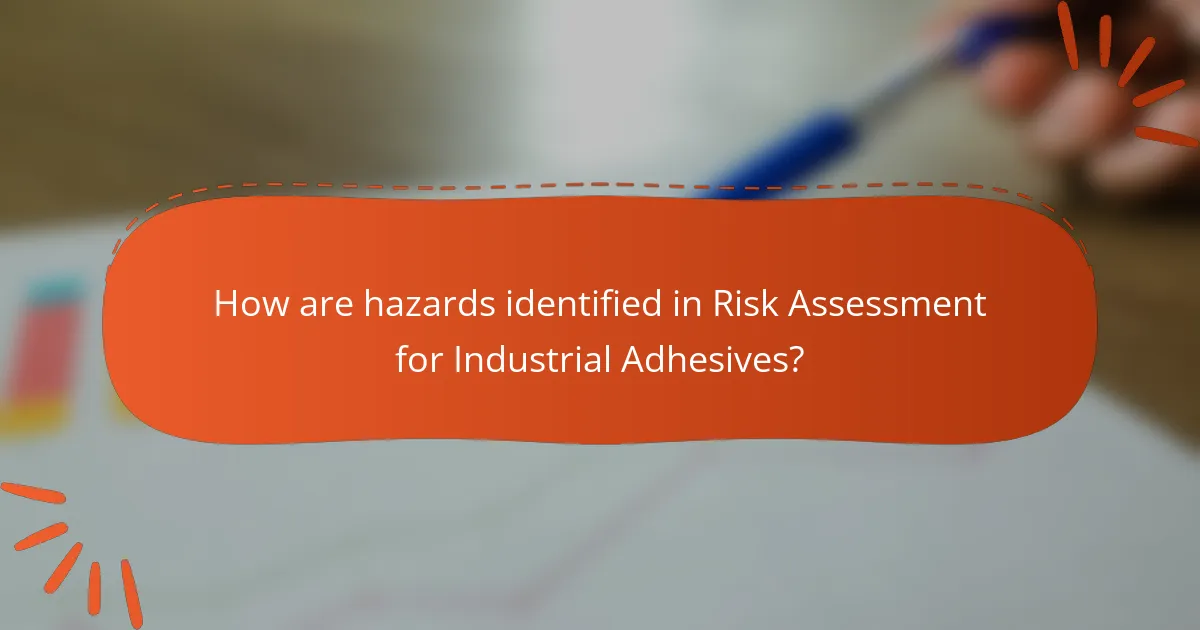
How are hazards identified in Risk Assessment for Industrial Adhesives?
Hazards in Risk Assessment for Industrial Adhesives are identified through a systematic process. This process typically includes reviewing Material Safety Data Sheets (MSDS) for chemical properties. Observing work practices and environments also plays a crucial role. Conducting interviews with employees can provide insights into potential hazards. Additionally, utilizing hazard identification tools like checklists enhances the assessment. Regulatory guidelines and industry standards further inform the identification process. Historical incident data can reveal patterns and common hazards associated with specific adhesives. Together, these methods create a comprehensive understanding of potential risks.
What techniques are used to identify hazards associated with industrial adhesives?
Techniques used to identify hazards associated with industrial adhesives include Material Safety Data Sheets (MSDS), hazard identification checklists, and exposure assessments. MSDS provide detailed information about the chemical properties and potential health effects of adhesives. Hazard identification checklists help systematically evaluate risks in the workplace. Exposure assessments measure the levels of adhesive exposure among workers. These techniques are essential for ensuring safety and compliance with regulations.
How does Material Safety Data Sheets (MSDS) contribute to hazard identification?
Material Safety Data Sheets (MSDS) contribute to hazard identification by providing detailed information about the properties of chemicals. They include data on toxicity, flammability, and reactivity. MSDS documents outline potential health effects and exposure routes. This information helps identify hazards associated with specific substances. Each MSDS is structured to include sections on hazard identification, first-aid measures, and handling precautions. By consulting MSDS, workers can understand risks and implement safety measures. The Occupational Safety and Health Administration (OSHA) mandates MSDS availability to ensure compliance and safety in workplaces. This regulatory requirement emphasizes the importance of MSDS in hazard identification processes.
What role does employee feedback play in hazard identification?
Employee feedback plays a crucial role in hazard identification. It provides firsthand insights from workers who directly interact with materials and processes. These insights can reveal potential risks that may not be apparent to management or safety officers. Employees often notice hazards related to equipment, procedures, or environmental conditions. Their feedback can lead to timely interventions that enhance workplace safety. Studies show that organizations with active feedback mechanisms report fewer incidents. Engaging employees in hazard identification fosters a culture of safety and accountability. Therefore, employee feedback is essential for effective risk assessment and hazard mitigation.
What are common hazards found in industrial adhesives?
Common hazards found in industrial adhesives include chemical exposure, flammability, and respiratory issues. Chemical exposure can occur from solvents and toxic ingredients in adhesives. Many adhesives contain volatile organic compounds (VOCs) that can be harmful. Flammability is another significant hazard, as some adhesives can ignite easily. This is especially true for those containing solvent-based formulations. Respiratory issues can arise from inhaling fumes during application. Prolonged exposure may lead to chronic health problems. Additionally, skin irritation can occur from direct contact with adhesives. These hazards necessitate proper safety measures and handling protocols in industrial settings.
What chemical hazards should be considered?
Chemical hazards to consider include toxic substances, flammable materials, and corrosive agents. Toxic substances can cause health issues upon exposure. Flammable materials pose fire and explosion risks. Corrosive agents can damage skin, eyes, and respiratory systems. Additional hazards may include irritants that affect skin and mucous membranes. Carcinogens are also critical to evaluate due to their long-term health effects. Understanding these hazards is essential for safe handling and usage in industrial settings. Proper safety data sheets (SDS) provide detailed information on these chemical hazards.
What physical hazards are associated with adhesive application?
Physical hazards associated with adhesive application include skin irritation, respiratory issues, and fire risks. Skin irritation can occur from direct contact with adhesives, leading to dermatitis. Respiratory issues may arise from inhaling fumes or vapors during application, particularly in poorly ventilated areas. Additionally, many adhesives are flammable, posing a fire risk if exposed to heat or open flames. Proper handling and safety measures are essential to mitigate these hazards.
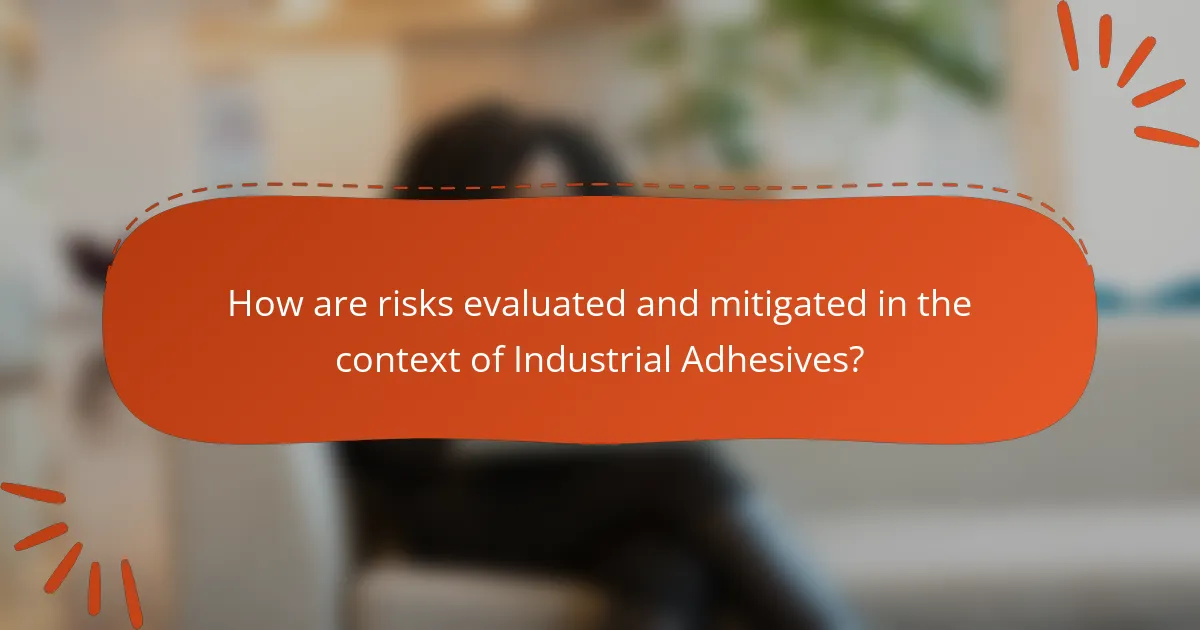
How are risks evaluated and mitigated in the context of Industrial Adhesives?
Risks in the context of industrial adhesives are evaluated through a systematic risk assessment process. This process includes identifying hazards associated with adhesive materials and their application. It involves assessing the likelihood and severity of potential adverse effects on health and safety. Tools such as Safety Data Sheets (SDS) and exposure assessments are utilized for this evaluation.
Mitigation strategies are then developed based on the evaluation findings. These strategies may include implementing engineering controls, using personal protective equipment (PPE), and improving ventilation systems. Training for employees on safe handling practices is also crucial. Regular monitoring and review of safety protocols ensure ongoing risk management.
This structured approach helps in minimizing risks associated with industrial adhesives effectively.
What steps are involved in evaluating risks for industrial adhesives?
The steps involved in evaluating risks for industrial adhesives include hazard identification, risk analysis, and risk evaluation. Hazard identification involves recognizing potential dangers associated with adhesive materials. This includes assessing chemical properties, exposure routes, and potential health effects. Risk analysis quantifies the likelihood and severity of identified hazards. This step often utilizes data from material safety data sheets (MSDS) and empirical studies. Risk evaluation compares the analyzed risks against acceptable standards. It determines if the risks are manageable or require mitigation measures. These steps ensure a comprehensive risk assessment for safe adhesive use.
How is likelihood assessed in risk evaluation?
Likelihood in risk evaluation is assessed through a systematic process. This process includes identifying potential hazards associated with industrial adhesives. Historical data, expert judgment, and statistical models are utilized to estimate the probability of adverse events. Each identified hazard is analyzed for its frequency of occurrence and potential impact. Risk matrices may be employed to categorize likelihood levels, such as rare, unlikely, possible, likely, and almost certain. Additionally, qualitative and quantitative methods can be applied for a more precise assessment. These methods help in prioritizing risks for effective mitigation strategies.
What methods are used to determine the severity of risks?
Methods used to determine the severity of risks include qualitative and quantitative assessments. Qualitative assessments involve expert judgment and risk matrices. These matrices categorize risks based on their likelihood and potential impact. Quantitative assessments use numerical data to calculate risk probabilities and impacts. Techniques like Failure Mode and Effects Analysis (FMEA) help identify potential failure points and their consequences. Additionally, Hazard and Operability Studies (HAZOP) systematically evaluate processes for risks. These methods are validated by industry standards and best practices in risk management.
What mitigation strategies can be employed for identified risks?
Mitigation strategies for identified risks include implementing safety protocols, using personal protective equipment, and conducting regular training. Safety protocols establish guidelines for safe handling and application of industrial adhesives. Personal protective equipment, such as gloves and masks, reduces exposure to hazardous substances. Regular training ensures that employees understand risks and safety measures. Additionally, conducting risk assessments periodically helps to identify new hazards. Implementing engineering controls, like proper ventilation, can also minimize exposure. These strategies collectively enhance workplace safety and reduce the likelihood of accidents.
How can engineering controls minimize risks in adhesive applications?
Engineering controls can minimize risks in adhesive applications by implementing physical changes to the work environment. These controls include local exhaust ventilation systems that capture harmful fumes at the source. Additionally, automated dispensing systems can reduce worker exposure to adhesives. Properly designed workstations can enhance ergonomics and minimize repetitive strain injuries. Regular maintenance of equipment ensures optimal functioning and safety. Furthermore, safety interlocks can prevent accidental exposure during machine operation. These measures collectively reduce the likelihood of accidents and health issues related to adhesive use.
What administrative controls are effective in managing adhesive risks?
Effective administrative controls for managing adhesive risks include implementing standard operating procedures (SOPs) and training programs. SOPs provide clear guidelines for safe handling and application of adhesives. Training programs educate employees on the hazards associated with adhesives and safe practices. Regular audits and inspections ensure compliance with safety protocols. Incident reporting systems help identify and address safety concerns promptly. Additionally, proper labeling and signage communicate hazards effectively. These controls reduce the likelihood of accidents and exposure to harmful substances. Implementing these measures aligns with regulations such as OSHA standards for workplace safety.
What best practices should be followed for effective risk assessment in industrial adhesives?
Effective risk assessment in industrial adhesives involves identifying hazards, evaluating risks, and implementing mitigation strategies. The first best practice is to conduct a thorough hazard identification process. This includes reviewing Material Safety Data Sheets (MSDS) for each adhesive used. Next, organizations should assess exposure scenarios, such as inhalation or skin contact, to determine potential health effects.
Regular training for employees on safe handling practices is essential. This training should cover proper use of personal protective equipment (PPE) and emergency response protocols. Another best practice is to implement a systematic risk evaluation process. This can involve qualitative and quantitative assessments to prioritize risks based on likelihood and severity.
Documentation of all risk assessment activities is crucial for compliance and continuous improvement. Regularly updating risk assessments to reflect changes in processes or materials is also necessary. Finally, engaging with stakeholders, including suppliers and safety experts, can enhance the effectiveness of risk management strategies.
Risk assessment for industrial adhesives is the systematic process of identifying potential hazards, evaluating risks, and implementing mitigation strategies associated with adhesive materials. This article explores the importance of risk assessment in ensuring workplace safety, compliance with regulatory standards, and the prevention of accidents related to chemical exposure, flammability, and health impacts. Key components include hazard identification, risk evaluation methodologies, and the role of Material Safety Data Sheets (MSDS) in hazard identification. Additionally, the article discusses the consequences of inadequate risk assessment and outlines best practices for effective risk management in industrial adhesive applications.
